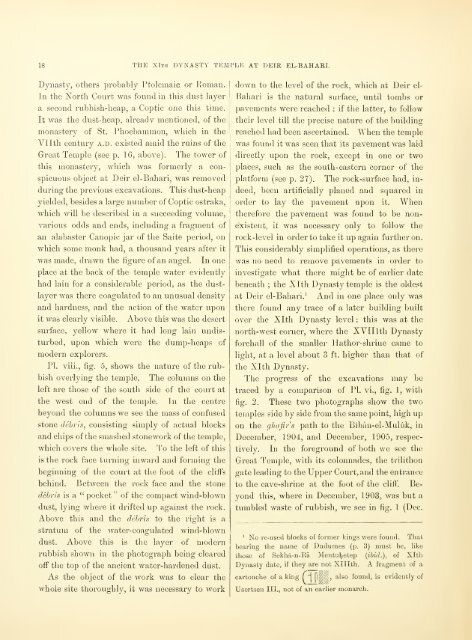The XIth dynasty temple at Deir el-Bahari .. - NYU | Digital Library ...
The XIth dynasty temple at Deir el-Bahari .. - NYU | Digital Library ...
The XIth dynasty temple at Deir el-Bahari .. - NYU | Digital Library ...
Create successful ePaper yourself
Turn your PDF publications into a flip-book with our unique Google optimized e-Paper software.
is TflE <strong>XIth</strong> <strong>dynasty</strong> TEMPLE AT DEIR EL-BAHARI.<br />
Dynasty, others probably Ptolemaic or Roman, j<br />
In the North Court was found in this dust layer<br />
a second rubbish-heap, a Coptic one this time.<br />
It was the dust-heap, already mentioned, of the<br />
monastery of St. Phoebaramon, which in the<br />
Vllth century a.d. existed amid the ruins of the<br />
Gre<strong>at</strong> Temple (see p. 16, above). <strong>The</strong> tower of<br />
this monastery, which was formerly a con-<br />
spicuous object <strong>at</strong> <strong>Deir</strong> <strong>el</strong>-<strong>Bahari</strong>, was removed<br />
during the previous excav<strong>at</strong>ions. This dust-heap<br />
yi<strong>el</strong>ded, besides a large number of Coptic ostraka,<br />
which will be described in a succeeding volume,<br />
various odds and ends, including a fragment of<br />
an alabaster Canopic jar of the Saite period, on<br />
which some monk had, a thousand years after it<br />
was made, drawn the figure of an ang<strong>el</strong>. In one<br />
place <strong>at</strong> the back of the <strong>temple</strong> w<strong>at</strong>er evidently<br />
had lain for a considerable period, as the dust-<br />
layer was there coagul<strong>at</strong>ed to an unusual density<br />
and hardness, and the action of the w<strong>at</strong>er upon<br />
it was clearly visible. Above this was the desert<br />
surface, y<strong>el</strong>low where it had long lain undis-<br />
turbed, upon which were the dump-heaps of<br />
modern explorers.<br />
PI. viii., fig. 5, shows the n<strong>at</strong>ure of the rub-<br />
bish overlying the <strong>temple</strong>. <strong>The</strong> columns on the<br />
left are those of the south side of the court <strong>at</strong><br />
the west end of the <strong>temple</strong>. In the centre<br />
beyond the columns we see the mass of confused<br />
stone debris, consisting simply of actual blocks<br />
and chips of the smashed stonework of the <strong>temple</strong>,<br />
which covers the whole site. To the left of this<br />
is the rock face turning inward and foi'mino; the<br />
beginning of the court <strong>at</strong> the foot of the cliffs<br />
behind. Between the rock face and the stone<br />
debris is a " pocket " of the compact wind-blown<br />
dust, lying where it drifted up against the rock.<br />
Above this and the debris to the right is a<br />
str<strong>at</strong>um of the w<strong>at</strong>er-coagul<strong>at</strong>ed wind-blown<br />
dust. Above this is the layer of modern<br />
rubbish shown in the photograph being cleared<br />
off the top of the ancient w<strong>at</strong>er-hardened dust.<br />
As the object of the work was to clear the<br />
whole site thoroughly, it was necessary to work<br />
down to the lev<strong>el</strong> of the rock, which <strong>at</strong> <strong>Deir</strong> <strong>el</strong>-<br />
<strong>Bahari</strong> is the n<strong>at</strong>ural surface, until tombs or<br />
pavements were reached : if the l<strong>at</strong>ter, to follow<br />
their lev<strong>el</strong> till the precise n<strong>at</strong>ure of the building<br />
reached had been ascertained. When the <strong>temple</strong><br />
was found it was seen th<strong>at</strong> its pavement was laid<br />
directly upon the rock, except in one or two<br />
places, such as the south-eastern corner of the<br />
pl<strong>at</strong>form (see p. 27). <strong>The</strong> rock-surface had, in-<br />
deed, been artificially planed and squared in<br />
order to lay the pavement upon it. When<br />
therefore the pavement was found to be non-<br />
existent, it was necessary only to follow the<br />
rock-lev<strong>el</strong> in order to take it up again further on.<br />
This considerably simplified oper<strong>at</strong>ions, as there<br />
was no need to remove pavements in order to<br />
investig<strong>at</strong>e wh<strong>at</strong> there might be of earlier d<strong>at</strong>e<br />
bene<strong>at</strong>h ; the <strong>XIth</strong> Dynasty <strong>temple</strong> is the oldest<br />
<strong>at</strong> <strong>Deir</strong> <strong>el</strong>-<strong>Bahari</strong>.^ And in one place only was<br />
there found any trace of a l<strong>at</strong>er building built<br />
over the <strong>XIth</strong> Dynasty lev<strong>el</strong> : this was <strong>at</strong> the<br />
north-west corner, where the XVIIIth Dynasty<br />
forehall of the smaller H<strong>at</strong>hor-shrine came to<br />
light, <strong>at</strong> a lev<strong>el</strong> about 3 ft. higher than th<strong>at</strong> of<br />
the <strong>XIth</strong> Dynasty.<br />
<strong>The</strong> progress of the excav<strong>at</strong>ions may be<br />
traced by a comparison of PI. vi., fig. 1, with<br />
fig. 2. <strong>The</strong>se two photographs show the two<br />
<strong>temple</strong>s side by side from the same point, high up<br />
on the giutfir's p<strong>at</strong>h to the Biban-<strong>el</strong>-Muluk, in<br />
December, 1904, and December, 1905, respec-<br />
tiv<strong>el</strong>y. In the foreground of both we see the<br />
Gre<strong>at</strong> Temple, with its colonnades, the trilithon<br />
g<strong>at</strong>e leading to the Upper Court, and the entrance<br />
to the cave-shrine <strong>at</strong> the foot of the cliff. Be-<br />
yond this, where in December, 1903, was but a<br />
tumbled waste of rubbish, we see in fig. 1 (Dec.<br />
' No re-used blocks of former kings were found. Th<strong>at</strong><br />
bearing the name of Dudumes (p. 3) must be, hke<br />
those of Sekha-n-Ea Mentuhetep (ibid.), of <strong>XIth</strong><br />
Dynasty d<strong>at</strong>e, if they are not Xlllth. A fragment of a<br />
cartouche of a king ( "| O^^j<br />
Usertsen III., not of an earlier monarch.<br />
^^^° found, is evidently of

















